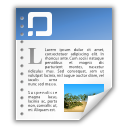| dc.description.abstract | One issue that today's teachers face is figuring out ways to get students motivated about learning, especially in the area of mathematics. In the past, teachers have utilized computers with projector screens and internet tools, such as Java applets, to demonstrate the dynamic nature of mathematics in an effort to motivate students. More recently, researchers and developers have introduced a new - though pricey - technological tool to the market in order to promote critical thinking and interactive learning in the classroom: the interactive whiteboard. The interactive whiteboard has the ability to run programs and demonstrations much like the computer-projector screen set-up, but with the added interactive capabilities.
The interactive whiteboard is designed to address specific known problems that learners face in terms of motivation, interest, challenge, interaction, and brain-based learning principles. Using the interactive whiteboard, teachers and students can manipulate images directly on the board instead of from behind a computer desk. The boards can also store all notes made on the presentations for future reference, making review of material easier and more accessible. Additionally, authentic and formative assessments are made easier through the use of the interactive whiteboard. Motivation is key to getting students to learn, and the interactive whiteboard is a step in the right direction to getting students motivated to learn mathematics. Challenging students is a way to help motivate them, as long as the task is not overly challenging, and the interactive whiteboard makes it easier for teachers to appropriately challenge their students. Just as motivation is important if learning is to take place, so too are the brain-based education principles - novelty, movement and intensity. The interactive whiteboard is a tool that, if used to its full extent, can increase novelty, movement and intensity in the mathematics classroom. That being said, training is a vital part of implementing the interactive whiteboard in the classroom if it is to be used to its full potential. Teachers must be provided with periodic trainings and continuing support systems for using the technology in order to get the most effective use out of the tool.
Conclusive findings have yet to be established on whether using interactive whiteboards in the mathematics classroom significantly improves student test scores. However, the qualitative data that has been collected has been largely in favor of the use of the boards due to the positive affect they seem to have on students' levels of attentiveness and excitement. Schools and principals should have reason to be excited about this new technology, but must exercise caution before purchasing one or more of the boards: arrangements must be made for sufficient training and ongoing support and all those involved must understand the realistic expectations from using an interactive whiteboard the whiteboard will not single-handedly improve student test scores, but, if used properly, it can help motivate and engage more students, which can lead to better learning and performance. | en |

